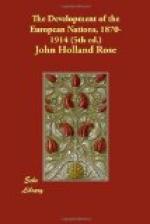His achievements as Deputy Assistant Quartermaster-General at Delhi and elsewhere at that time need not be referred to here; for he himself has related them in clear, life-like, homely terms which reveal one of the sources of his personal influence. Englishmen admire a man who is active without being fussy, who combines greatness with simplicity, whose kindliness is as devoid of ostentation as his religion is of mawkishness, and with whom ambition is ever the handmaid of patriotism. The character of a commander perhaps counts for more with British troops than with any others, except the French; and the men who marched with Roberts from Cabul to Candahar, and from Paardeberg to Bloemfontein, could scarcely have carried out those feats of endurance for a general who did not possess both their trust and their love.
The devotion of the Kurram column to its chief was soon put to the test. After advancing up that valley, girt on both sides with lofty mountains and scored with numerous gulleys, the force descried the Peiwar Kotal Pass at its head—a precipitous slope furrowed only in one place where a narrow zigzag path ran upwards through pines and giant boulders. A reconnaissance proved that the Afghans held the upper part in force; and for some time Roberts felt the gravest misgivings. Hiding these feelings, especially from his native troops, he spent a few days in reconnoitring this formidable position. These efforts resulted in the discovery by Major Collett of another practicable gorge further to the north leading up to a neighbouring height, the Peiwar Spingawi, whence the head of the Kotal might possibly be turned.
To divide a column, comprising only 889 British and 2415 native troops, and that too in face of the superior numbers of the enemy, was a risky enterprise, but General Roberts determined to try the effect of a night march up to the Spingawi. He hoped by an attack at dawn on the Afghan detachment posted there, to turn the main position on the Kotal, and bring about its evacuation. This plan had often succeeded against Afghans. Their characteristics both in peace and war are distinctly feline. Prone to ease and enjoyment at ordinary times, yet, when stirred by lust of blood or booty, they are capable of great feats of swift fierce onset; but, like all men and animals dominated by sudden impulses, their bravery is fitful, and is apt to give way under persistent attack, or when their rear is threatened. The cat-like, stalking instinct has something of strategic caution, even in its wildest moods; it likes to be sure of the line of retreat[311].
[Footnote 311: General [Sir] J.L. Vaughan, in a Lecture on “Afghanistan and the Military Operations therein” (December 6, 1878), said of the Afghans: “When resolutely attacked they rarely hold their ground with any tenacity, and are always anxious about their rear.”]




